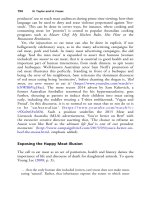The palgrave international handbook of a 459
Bạn đang xem bản rút gọn của tài liệu. Xem và tải ngay bản đầy đủ của tài liệu tại đây (27.49 KB, 1 trang )
Legal and Illegal Theriocide of Trafficked Animals
461
run businesses breeding and selling parrots (see below). This may indicate
their business is a means by which they launder wild caught birds, for
example, owners may claim that they breed the birds, when in reality they
are illegally trafficked to the country. Import of cheap wild caught birds may
also sustain their business and provide an addition to their own parrot
breeding if the results are insufficient.
Data/Methodology
The seizure reports, completed by Customs officers when animals (or any
illegal goods) are seized at Norwegian borders, contain information about the
animals, the location and circumstances for the seizure, in addition to
information provided by the person carrying/sending animals about his/her
intention behind the act and in general his/her explanation for it. I have
traced several of the cases that have been produced by the prosecutor as a
consequence of these confiscation reports through a number of phone calls to
determine how they ended, that is, with a verdict (if the case was brought to
trial). Most often, however, they end with a fine or are dismissed.
In addition, in Norway, I conducted 12 semi-structured individual and
group interviews with people, who, because of their profession, e.g., as
veterinarians, police and customs officers, have specific insight into the illegal
wildlife trade. Groups comprised from three to six persons. In addition, I
interviewed five offenders (reptile keepers). I also carried out manifold email
exchanges and had numerous phone conversations with police, prosecutors
and experts. I have conducted further 18 interviews from South America (14
from Colombia and four from Brazil) with veterinarians, wildlife experts,
NGO staff, and environmental police.11 Analysis of newspaper articles that
are too many to detail here, on the subject, were also a part of my research.
11
Secretaría ambiental de ambiente; Asociación de veterinaries de vida silvestre; TRAFFIC (Latin
America) Fundación Proaves; Centro de recepción y rehabilitación de vida silvestre; ARIE Matão de
Cosmópolis/ICMBio, Secretaría de Meio Ambiente do Sao Paolo, Corporación para el Desarrollo
sostenible del Norte y oriente Amazónico; Secretaria Municipal do Verde e do Meio Ambiente—Sao
Paulo; Ministerio de Ambiente y Desarrollo Sostenible; Policía Militar Ambiental—Sao Paulo; Entropika.
Persons in Colombia and Brazil who want to be credited for their participation in the project are
Claudia Isabel Brievar Rico, Bernardo Ortíz von Halle, Javier Cifuentes, Mỏrcia Gonỗalves Rodrigues,
Claudia Terdiman Schaalmann, Daniela Desgualdo, Wilfredo Pachón, Ricardo Gandara Crede, Claudia
Rodríguez, Marcelo Robis Francisco Massaro and Angela Maldonado.
Interviews in Norway (17) were conducted by the author, while interviews in Colombia and Brazil
(with the exception of one interview done by the author on SKYPE) were conducted by David
Rodríguez Goyes, for which I am grateful.









